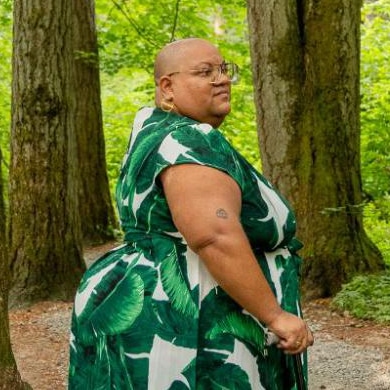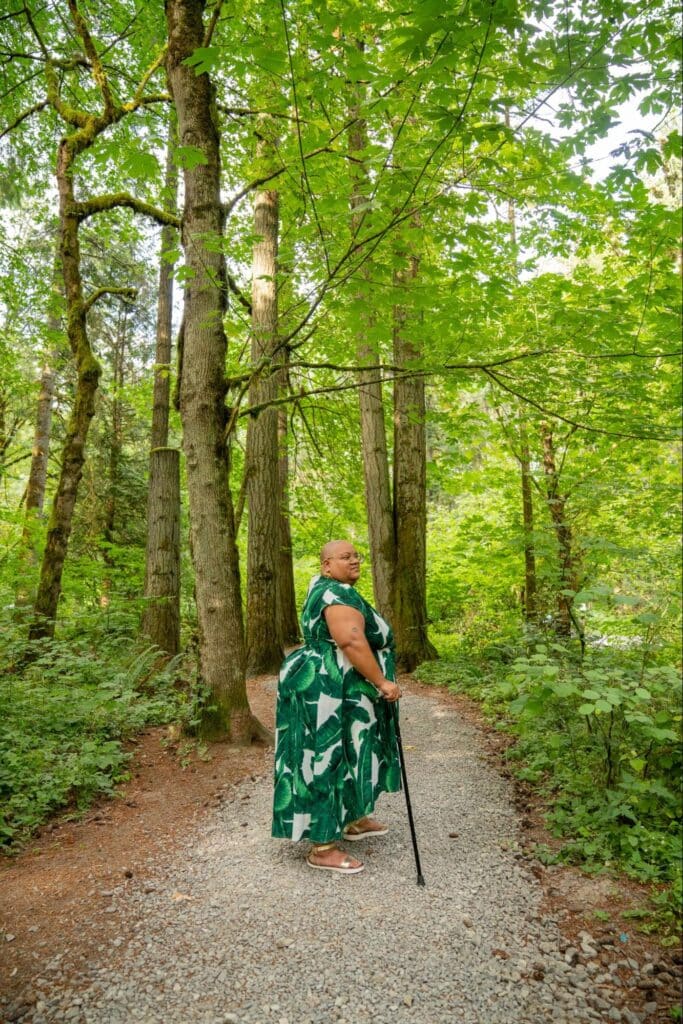
By Kristie Cabrera
Kristie Cabrera is a queer, non-binary, Latine, disabled, and neurodivergent accessibility and inclusion consultant with a background in occupational therapy. Their work is rooted in disability justice. They inspire land-based organizations to dream about accessibility and inclusion. They provide tailored tools, strategies, and training to weave these dreams into reality.
A few years ago, I was working as an occupational therapist in a school and facing constant hostility from management. My access needs – requests for simple accommodations – were being denied without reason. Immersing myself in nature became my escape from the stress. I attended as many community gardens, plant walks, and farm tours as I could. Initially grounding, these experiences soon frustrated me. While these spaces advocated for environmental justice, they were largely inaccessible to disabled people.
Disability and environmental justice are deeply interconnected, yet many view them as distinct movements. My frustration led me to action; I now consult with land-based organizations to help them become more accessible and inclusive. Land-based organizations include any organization that works with the land in some capacity, such as gardens, parks, farms, food justice organizations, etc. Working with land-based organizations usually means helping people to see access as an act of community care and love, not an impossible obstacle that can only be tackled with obscene amounts of money. Quite often I start by recommending simple solutions, like including a description of not only the space’s current access barriers but what people can expect (ex: planned activities, sensory experiences, required participation, etc.) for any events or gatherings the land-based organization is hosting. This simple recommendation provides information for disabled people to decide on whether or not their access needs will be met or if they need accommodation. However, focusing on accessibility is just a small piece of the puzzle. To effectively address the needs of both people and the planet, we must recognize their intersection. Environmental justice organizations and advocates need to prioritize inclusion of disabled people as full and equal participants in the movement, ensuring that their voices, perspectives, and needs are integral to shaping solutions.
What is Disability Justice?
The disability rights movement was critical in securing basic civil rights for disabled individuals. But, it was not without flaws. Focused mainly on mobility impairments, the traditional disability rights movement was not intersectional , and used a legal framework that does not guarantee collective liberation.
Patty Berne and Mia Mingus, queer disabled Women of Color, highlighted these limitations in 2005. They sparked conversations that included influential figures like Leroy Moore, Stacey Milbern, Eli Clare, and Sebastian Margaret.
Their discussions resulted in the creation of disability justice, a framework and movement that embraces the uniqueness of all bodies. As Patty Berne explains in their “Disability Justice – a working draft” blog post, “A Disability Justice framework understands that all bodies are unique and essential, that all bodies have strengths and needs that must be met. We know that we are powerful not despite the complexities of our bodies, but because of them…” Unlike the traditional disability rights movement, disability justice is led by those most impacted, including Black and Brown queer and trans individuals.
Fighting for the Same Reason
Disability justice and environmental justice both emerged from marginalized communities striving to confront systemic inequalities. These inequalities are rooted in capitalism, seeking to dictate people’s value. Disabled individuals are often perceived as unworthy, leading to systemic isolation, barriers to basic necessities, and a struggle for mere survival. When these issues are brought up, they are consistently neglected. Still to this day, 30+ years after the Americans with Disabilities Act (ADA) was passed, organizations and governments continue to create inaccessible buildings and spaces. Similarly, throughout history, Black and Brown bodies—disabled or not—have been deemed unworthy, with their communities targeted for environmental harm. This includes direct pollution, insufficient resources for maintaining clean communities, limited access to natural spaces, and pervasive neglect when harmful conditions are reported.
Impacted by Climate Change
Climate disasters are impacting communities worldwide, even those once deemed safe. Record-breaking temperatures, devastating hurricanes, and raging wildfires are displacing countless individuals and destroying homes. Staying safe in the face of climate change requires careful planning, including creating safety plans, gathering essential supplies, and preparing for evacuation. Unfortunately, in the United States, disabled individuals and People of Color are more than twice as likely to live in poverty, limiting their access to the resources and time necessary for effective disaster preparedness.
Limited Access to Green Spaces

Image is from the Disabled And Here collection.
Reduced access to green spaces is another critical issue, adversely affecting the physical and mental health of Black, Brown, and disabled communities. From redlining to the demolition of communities for developments favoring white, middle- and upper-class citizens, systemic racism has restricted access to land in all shapes and forms for Black and Brown communities. Disabled individuals also face barriers that make it difficult to access these spaces. Most parks and community gardens lack accessibility features, such as sufficient parking and inclusive design. Public programming often fails to accommodate disabled individuals, further limiting their access. These barriers deprive us of opportunities for meaningful engagement with the land, including ancestral and cultural practices. Climate change and limited access to green spaces are just two of many examples showcasing the intersection of disability justice and environmental justice. To create meaningful change, environmental justice organizers must examine their practices through an accessibility lens. What are some ways to make inclusive change?
- Making websites and content more accessible by adding audio descriptions, image captions, and ensuring easy navigation;
- Inviting disabled people to leadership roles;
- Incorporating disability justice principles into your work; and
- Investing in disability training (awareness of different disabilities, accessibility and inclusion, accommodation, etc.)
By prioritizing inclusivity, these movements can enrich their advocacy, leading to a deeper understanding of the interconnected challenges faced by marginalized communities. Ultimately, fostering collaboration between disability and environmental justice is essential for effective advocacy that uplifts all voices.
Check out Kristie’s website to learn more about them and follow them on Linkedin.